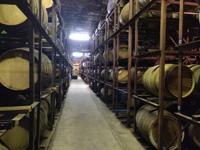What is an ex-bourbon barrel?
Contents

Ex-bourbon barrels are whisky casks which have been previously used to mature American Bourbon. These casks are prized within the scotch whisky industry and often used until exhaustion.
If you enjoy Scottish single malts, you can hardly avoid American Bourbon Whiskey. Because what many do not know: Around 95% of all Scottish single malts mature in ex-bourbon barrels sourced from the USA. We present this type of barrel with its peculiarities and reveal why Scottish distilleries swear by American barrels.
Scottish single malts always mature in oak barrels but in most cases these are not new barrels (so-called Virgin Oak Casks). These would be too intense with longer maturation, the spicy and spicy wood notes would overlay the finer aromas of a single malt. Instead, discarded bourbon barrels from the USA are used for storage in almost all distilleries around the world.
Why do so many Scottish single malts mature in bourbon barrels?
An important peculiarity characterizes American bourbon whiskey: by law, it must be stored in new, freshly burned-out barrels. These mostly consist of American oak. New means that each barrel or barrel may only be used once. Following prohibition, the regulation was introduced in order to safeguard jobs for coopers (barrel makers) in the USA. A regulation which has survived to this day, which means that ex-bourbon barrels are constantly available in large quantities.
Because while Scottish single malts often mature for 10 years or more, it is often 4-8 years for bourbon whiskey. Whiskey matures a little faster in the warmer Kentucky climate. The barrels are hardly used after the first filling and are often practically new.
Another advantage results from the wood used: because the American oak (Quercus Alba) contains a particularly large number of tyloses - these are bubble-shaped cell structures that make the wood particularly impermeable to water. The barrels can thus be made from thinner staves and above all by machine.
Ex-bourbon barrels are comparatively cheap to buy: A Scottish distillery pays around £100 to £200 for a bourbon barrel, while Spanish sherry butts sometimes have to be put on the table for £700 to £1,200. French wine or cognac barrels can quickly cost several thousand pounds.
What flavors does a bourbon barrel produce?
The American white oak, from whose wood the bourbon barrels are built, is characterized by a high vanilla content. The aromas of vanilla also find their way into the bourbon whiskey. Notes of caramel or nutty nuances can often be seen. Roasted notes are added depending on the intensity of the burning out of the barrel.
The bourbon bundles these flavors in itself, while some of it remains in the barrel walls - until its notes combine with those of Scottish single malts when refilled.
The mechanical production of the bourbon barrels and the consistency of the whiskey stored in it also ensure that the quality and aromas of the American barrels are relatively predictable. This is an advantage for the Scotch distilleries, because here too the aim is to establish a reliable character in single malt or blends.
First fill or second fill - what’s the difference?
Some Scottish distilleries state whether a single malt has been matured in a first-fill or a refill bourbon cask. A first-fill cask is a first-filled barrel that previously only contained the bourbon whiskey. This barrel releases the most intense aromas from the pre-allocation to the single malt now stored in it.
In Scotland, barrels can be used as often as required and so many ex-bourbon barrels are filled with malt whisky a second time (second-fill) or even more often (refill-bourbon cask). With each further filling, however, the number of aromas from the barrel decreases, the wood becomes more and more exhausted and can contribute fewer aromas. However, such ex-bourbon barrels, which are often used, can be refreshed again by grinding (shaving) and re-charring, a process known as rejuevenation.
How big is an ex-bourbon barrel?
A typical bourbon barrel commonly known as an American Standard Barrel (ASB) holds 200 liters. In Scotland, however, Hogshead barrels have prevailed, which have a volume of between 225 to 250 liters.
Hogsheads are often reassembled from ex-bourbon barrels. Experienced cooperators insert additional barrel staves. In this way, more whiskey can be aged in the barrel without affecting the stability of the cask. At the same time, the barrel maker checks whether the barrel is really tight and can withstand the pressure of the newly filled malt whisky. Because nothing is more annoying (and expensive) than a leaky barrel from which precious whisky is lost.
Previous
Next

